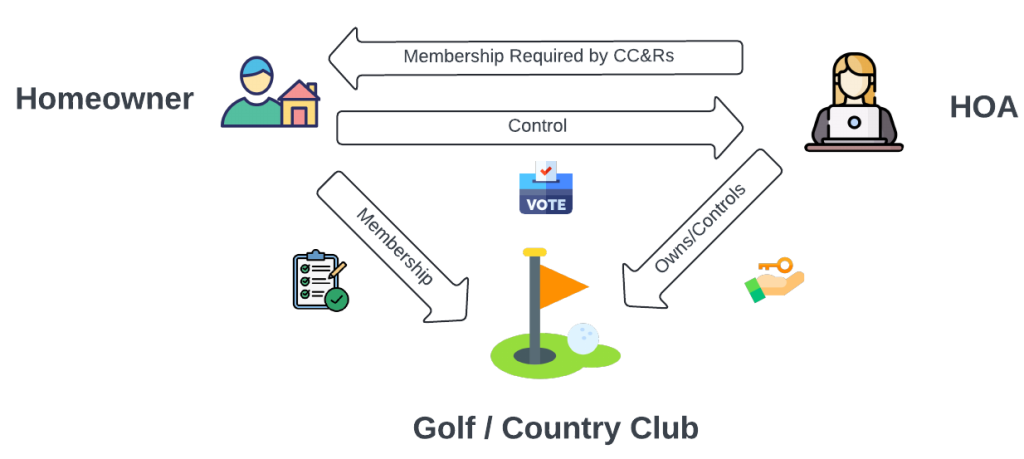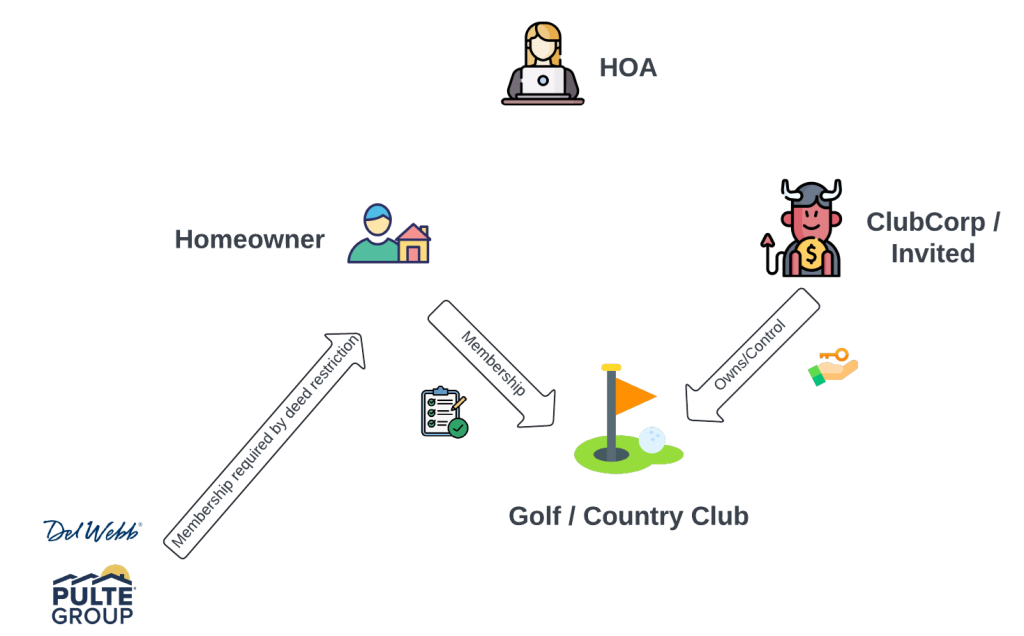THE PROBLEM -IN PICTURES
Pictures can often tell a better story than long-winded posts, so here’s an attempt to visually compare typical club arrangements to what we have with Anthem Golf & Country Club.

Association-Owned Property With Mandatory Membership
This is a common arrangement and has applied to various types of clubs that are situated within communities. In this case, the underlying community documents (the CC&Rs) mandate membership to the club and the association collects fees related to the membership.
If a significant number of homeowners don’t like the requirement, they can use their votes for the HOA board with the intent of altering the CC&Rs or actions by the association (e.g., lowering dues, etc.).
Pros:
- Distributes the operations costs across all homeowners
- Club policies, membership requirements, etc. can be impacted by electing board members aligned with the individual’s agenda.
Cons:
- Distributes the operations costs across all homeowners, even if a homeowner doesn’t find value in the club
- May lead to lower property values
- You have to sell your home if you can’t influence change.
- Voting in associations often results in low turnout, which can result in a disproportionate impact of a few individuals.

Member-Owned Clubs
In member-owned clubs, a certain class of members or all members have an ownership stake in the club. For example, you might have a membership that grants ownership and voting rights and a membership that just allows for facilities usage.
In this case, the club is owned by that pool of members and operated by the board, which is elected by the voting members. Membership is not required and can be terminated at the member’s discretion.
Pros:
- Membership is optional
- Homeowners can have skin in the game and profit off of their memberships
- Members can leave at their discretion or within an agreed-upon set of terms
- The club has to perform for the membership cost against what it delivers, otherwise it won’t survive
Cons:
- Distributes the operations costs across all homeowners, even if a homeowner doesn’t find value in the club
- Club board votes can also be highly political and based on social relationships rather than the ability to effectively lead and manage a business

Third-Party Clubs
For third-party clubs, while there may be a loose association with the community, that is not required. In this arrangement, membership is purely optional and at the discretion of the homeowner. In fact, ClubCorp/Invited’s Seville Golf & Country Club is an example of this.
Pros:
- Membership is optional
- Members can leave at their discretion or within an agreed-upon set of terms
- The club has to perform for the membership cost against what it delivers, otherwise it won’t survive
Cons:
- No say in the operation of the club, but homeowners can vote with their wallet

Anthem Golf & Country Club
In our arrangement, which deviates from every norm, the developer was responsible for creating a deed restriction which created this mandatory requirement – it is not in the CC&Rs. This is why the HOA is just floating in space, doing absolutely nothing. This deed restriction is excluded from our official “community documents” page on the overall association that governs the entire community.
The developer then sold to ClubCorp (aka Invited), who can in turn, sell it to anyone else.
We do not have an actual vote or voting process. To alter the deed restriction requires 67% of homeowners AND the club owner to approve of it. Thus, even if 100% of the residents wanted change, our voice is unilaterally vetoed by the owner.
Better yet – homeowners aren’t even allowed to own the club, per the deed restriction. So, even if we wanted to pool our money together and purchase it, we can’t.
Pros:
- Distributes the cost of operations across all members, even if they don’t use the facilities
Cons:
- Run by a for-profit entity that operates for profit optimization, e.g., reduces or eliminates services during summer when “snowbirds” leave the community
- Can literally shut their doors and keep billing
- Distributes the operations costs across all homeowners, even if a homeowner doesn’t find value in the club
- May lead to lower property values
- No voting process to govern the behavior or operations of the club
- Allows members of the public to enter a gated community, for no benefit to the community
- Must sell your home to exit the contract
- The only method to alter the deed restriction can be unilaterally vetoed by The Club
- The Club has powers that are reserved for HOAs, even though it is not one
- Club does not need to perform or provide cost-commensurate services since it has a guaranteed revenue base from all homeowners
- Arguably an anti-competitive element with respect to the restriction of who can own the club.
As you can see, the other arrangements exhibit some degree of balance between their positives and negatives and all fundamentally allow homeowners the right to vote – be it with an election or their wallet. The arrangement with Anthem Golf & Country Club does not.
Copyright © 2024 Panimus Consulting, LLC